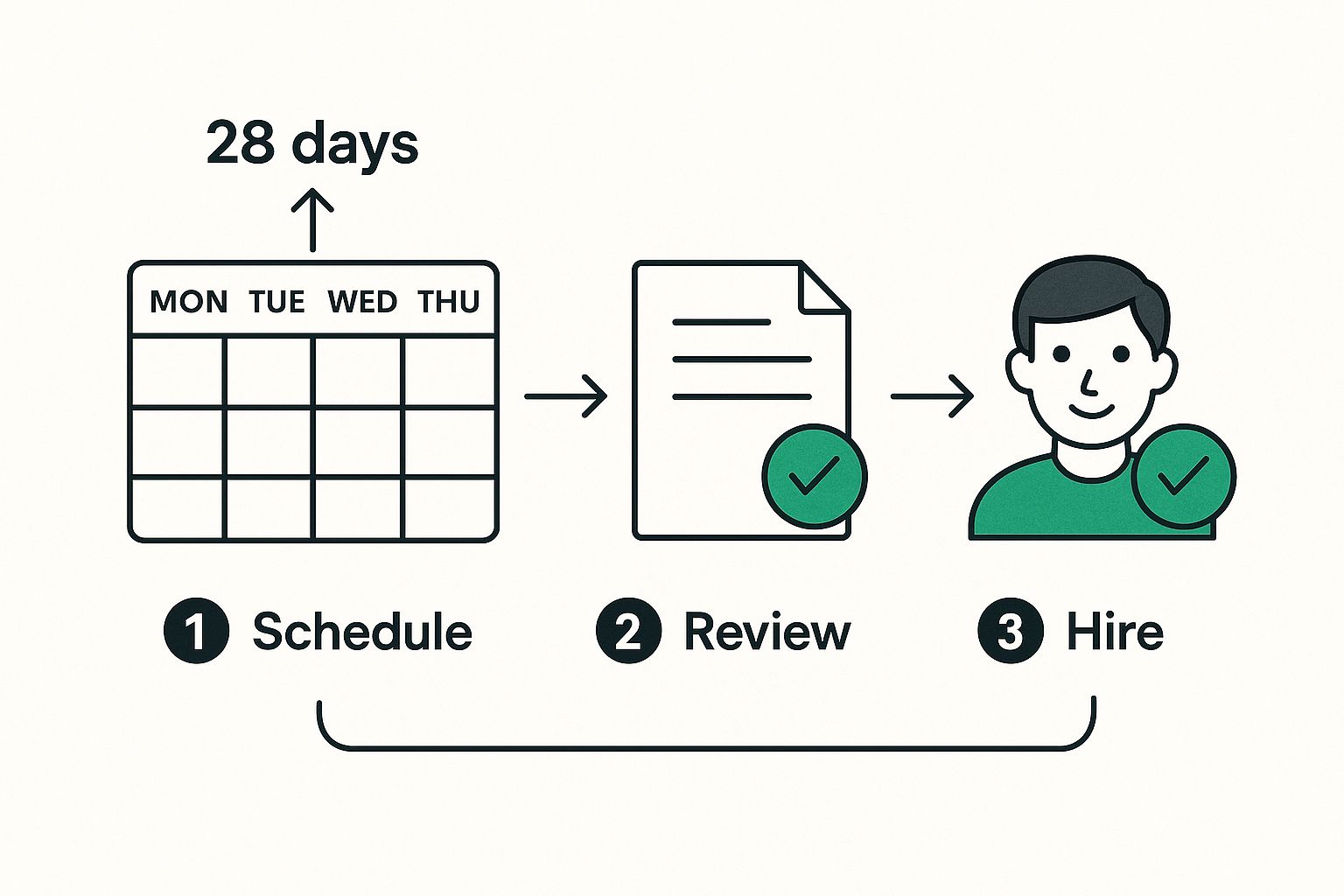
How to Calculate Holiday Entitlements: UK Guide
Posted by Robin on 16 Oct, 2025 in
Getting holiday entitlement calculations right can feel like a minefield, but it's actually more straightforward than you might think. Everything hinges on one magic number: 5.6 weeks. This is the statutory minimum paid holiday that almost every worker in the UK is entitled to.
For your typical full-timer, that works out to a neat 28 days per year.
Understanding UK Holiday Pay Fundamentals

Before we jump into the formulas, it's crucial to get your head around the two types of holiday leave we have here in the UK. Nailing this distinction is the foundation for every accurate holiday calculation and keeps your business on the right side of employment law.
The two main categories you'll deal with are:
- Statutory Entitlement: This is the bare minimum leave you must provide by law.
- Contractual Entitlement: This is any extra leave you choose to offer on top of the statutory minimum, which will be laid out in the employment contract.
Statutory vs Contractual Entitlement
Let's break that down a bit more. Statutory entitlement is completely non-negotiable. Every single worker, whether they're part-time or on a zero-hours contract, gets those 5.6 weeks of paid holiday. Simple as that.
Many employers, however, offer more than this as a perk. It's a great way to attract and retain talent. This is where contractual entitlement comes in. For instance, offering 30 days plus bank holidays is a common contractual benefit that goes above and beyond the legal floor.
Knowing the difference is vital. If a contract says an employee gets "28 days holiday including bank holidays," you're looking at the statutory minimum. But if it says "25 days holiday plus bank holidays," their total entitlement is actually 33 days—a more generous contractual arrangement.
For a quick breakdown, here’s how the two stack up against each other.
Statutory vs Contractual Holiday Entitlement At a Glance
| Feature | Statutory Entitlement | Contractual Entitlement |
|---|---|---|
| Basis | Set by UK law; the legal minimum. | Set by the employer in the contract. |
| Amount | 5.6 weeks per year (capped at 28 days). | The statutory minimum plus any additional days. |
| Flexibility | Non-negotiable; cannot be reduced. | Can be more generous and vary between employees. |
| Example | 28 days including bank holidays. | 25 days plus bank holidays (totalling 33 days). |
This table is a handy reference, but the golden rule is to always check the employment contract first. It's your single source of truth.
The legal framework is crystal clear: the standard full-time holiday entitlement works out to 28 days of paid annual leave per year. This leave builds up over time, accruing at a rate of 2.33 days for each month worked. This system is essential for fairness, especially for staff who join or leave part-way through the year. You can dive deeper into the legal side of things in our guide to UK holiday entitlement.
Key Takeaway: Always, always check the employment contract first. It will tell you whether you're working with the statutory minimum or a more generous contractual allowance. This is the starting point for any calculation.
Remember, holiday pay is just one piece of the puzzle. To get a full picture for budgeting and compliance, it helps to understand the total cost of hiring. Using a true cost of an employee calculator can shed some light on this.
Calculating Leave for Full-Time Employees
Let's start with the most common setup: calculating holiday entitlement for a full-time employee on a standard five-day week. The statutory minimum here is 5.6 weeks. For this kind of employee, that translates neatly into 28 days of paid leave per year.
Right off the bat, you need to decide how to handle bank holidays. This is a crucial detail that needs to be crystal clear in your employment contracts. Will those public holidays be part of the 28-day total, or will you offer them on top? Your choice here makes a real difference to an employee's total time off.
Two Approaches to Bank Holidays
There are really only two ways to play this, and both are straightforward. You either wrap the bank holidays into the statutory 28 days, or you give them as an extra.
- The Inclusive Method: The employee gets 20 days of holiday to book whenever they like, plus the 8 standard UK bank holidays. This brings them up to the total of 28 days.
- The Exclusive Method: The employee gets 28 days of holiday to book freely, in addition to the 8 bank holidays. This is a more generous package, resulting in 36 days of total paid leave.
This simple infographic breaks down how a standard five-day week lines up with the 28-day statutory minimum.

Think of this as the baseline calculation before you factor in the specific contractual details around bank holidays.
Putting it into Practice
To see how this works in the real world, let's imagine you have two full-time employees, Alex and Ben.
Alex’s contract states, "28 days annual leave, inclusive of bank holidays." This means he gets 20 days to book as he pleases, with the remaining 8 being the fixed bank holidays. Ben’s contract, however, offers "28 days annual leave plus bank holidays." He gets a full 28 days to book whenever he wants, and the bank holidays are completely separate, paid days off.
Being absolutely clear in your employment contracts is the best way to avoid any confusion or disputes down the line.
Mastering Pro-Rata Holiday Calculations

Figuring out pro-rata holiday for part-time staff is one of those areas where businesses often get tangled up. But it doesn’t have to be a headache. Forget complex spreadsheets; a simple multiplier is all you need to ensure fairness and stay compliant.
This approach makes sure your part-time team members get their holiday entitlement in direct proportion to the days they work.
The core formula is beautifully simple: take the full-time entitlement (usually 28 days), divide it by five (the standard working week), and then multiply it by the number of days the part-time employee works.
Let's walk through a real-world example. Imagine your full-time staff get the statutory 28 days. You've just hired a new team member, Chloe, who will be working three days a week.
Here’s the quick calculation for her pro-rata holiday:
- (28 days / 5 days) x 3 days worked = 16.8 days
So, Chloe is entitled to 16.8 days of paid leave for the year. In practice, most employers round this up to the nearest half or full day to keep things tidy. In this case, you’d round it up to 17 days.
For a more detailed breakdown, our complete UK guide on how to calculate pro-rata holiday has you covered.
Calculating Leave for Starters and Leavers
The same pro-rata principle is your best friend when an employee joins or leaves part-way through your holiday year. You’ll need to work out what they've accrued up to their start or end date to make sure their final pay is spot on.
The calculation is based on the proportion of the year they've actually worked. Someone leaving halfway through the year, for instance, would be entitled to half of their total annual leave.
Let's stick with our example. If Chloe (who works three days a week and gets 17 days of holiday) leaves after six months, she will have accrued exactly half of her annual entitlement: 17 days / 2 = 8.5 days. You would then just deduct any leave she's already taken to figure out her final holiday pay.
Because these calculations often come down to working out a portion of the full amount, having a solid grasp of the principles of percentages is incredibly helpful.
It’s also worth remembering that many UK employers offer more than the statutory minimum, often providing 30 days or more, including bank holidays. If your full-time staff get a more generous contractual allowance, your part-time workers are legally entitled to the prorated equivalent. It’s all about ensuring fairness across the board.
Navigating Complex Holiday Scenarios
The world of work isn't the simple nine-to-five it once was. With casual staff, zero-hours contracts, and all sorts of irregular schedules becoming the norm, calculating holiday entitlement can feel like a minefield. Thankfully, there’s a reliable method for getting it right with these non-standard work patterns.
For any worker with irregular hours, the fairest and most accurate way to calculate their leave is by using a percentage of the hours they’ve actually worked. The standard statutory rate for this is 12.07%. This isn't just a number plucked from thin air; it represents the 5.6 weeks of statutory leave as a percentage of the remaining 46.4 working weeks in a year.
The Percentage Method in Action
Let’s put this into practice. Imagine you have a team member on a zero-hours contract who clocked in 80 hours over the last month. To figure out their holiday accrual, you just need to multiply the hours they worked by that key percentage.
Here’s how the calculation looks:
- 80 hours worked x 12.07% = 9.66 hours of holiday accrued
Using this method ensures their holiday entitlement is directly tied to the work they've done. It's the most transparent and legally sound way to manage it, which is especially important given recent legal updates that have cemented this approach for part-year and irregular-hours workers.
Statutory Leave Accrual
But what happens when an employee is away from work for a long stretch, perhaps on maternity, paternity, or long-term sick leave? This is a common point of confusion for many managers, but the rule is refreshingly simple: their holiday entitlement continues to build up just as if they were still at work.
This applies to both their statutory allowance and any extra contractual leave you offer. An employee’s right to paid holiday is a core part of their employment terms, and that right is protected during these types of statutory leave.
Before an employee comes back, you should work out the total holiday they've accrued while they were away. It’s always good practice to sit down with them and discuss a plan to use this leave. They might want to take a block of time off right after they return or spread the days out over the rest of the leave year.
It’s also absolutely crucial to manage accrued leave correctly when someone leaves your team. For a clear overview on this, you can explore our guide on handling holiday entitlement when leaving a job. Getting this right ensures their final pay is accurate and you remain fully compliant. When you manage these tricky scenarios properly, it builds trust and shows your team you’re committed to being fair.
Common Holiday Management Mistakes to Avoid
Figuring out holiday entitlements is one thing, but actually managing them day-to-day is where the real headaches can start. A clear, fair holiday policy is your foundation, but even the best-laid plans can go sideways if you fall into a few common traps.
One of the biggest culprits is a messy approach to carrying over leave. Without a firm policy on what happens to unused days, you’ll either have staff losing valuable time off or trying to book a massive chunk of holiday at the most inconvenient time possible. It’s a bigger issue than you might think, too. On average, UK employees leave five days of their annual leave on the table each year. You can dig into the reasons why by exploring the latest annual leave statistics for 2024-2025.
Poor Communication and Inconsistent Rules
Another classic slip-up is simply not being clear enough. If your team doesn't understand the process for getting leave approved, how much notice they need to give, or how you handle clashes during busy periods, it just breeds frustration and a sense of unfairness. Being consistent is absolutely everything.
Here are a few classic missteps I see all the time:
- Relying on "corridor conversations": Taking verbal holiday requests is a recipe for disaster. Someone will forget, something won't get logged, and suddenly you're short-staffed. Always, always have people submit requests through a proper system to keep a clear audit trail.
- Playing favourites with approvals: Even if you don’t mean to, approving requests for some people quicker than others will absolutely kill team morale. A simple, well-communicated "first-come, first-served" policy is nearly always the fairest way to go.
- Forgetting part-timers and bank holidays: This is a surprisingly common mistake. Failing to correctly pro-rata bank holiday entitlement for your part-time staff means you're not giving them what they're legally owed.
The holiday policies that work best are the ones that are written down, easy for everyone to find, and applied the exact same way for every single employee. When you’re transparent, you remove all the guesswork and build trust.
By getting ahead of these issues and putting simple, clear processes in place, you’ll build a system that’s not just legally compliant, but also fair and easy for everyone to use.
Got Questions? We've Got Answers
Holiday entitlement is a minefield of 'what ifs' and tricky scenarios. It's one of those areas where small details really matter. We get asked about the nuances all the time, so let's tackle a few of the most common questions that trip employers up.
Can I Include Bank Holidays in the Statutory 28 Days?
Yes, you absolutely can. There's no law stopping you from counting the standard eight UK bank holidays as part of an employee's minimum 5.6 weeks (28 days) of statutory leave.
The crucial part, however, is your employment contract. It must be crystal clear about this. If your contract is vague, or worse, says something like "28 days plus bank holidays," then you’re legally on the hook for providing the bank holidays on top of the 28 days. When it comes to contracts, clarity is your best friend.
What Happens to Holiday Entitlement During Maternity Leave?
This is a big one, and the law is very clear: holiday entitlement continues to build up as normal for the entire time an employee is on maternity leave. This includes both their Ordinary and Additional Maternity Leave periods, and it covers their full entitlement – both the statutory minimum and any extra days you offer contractually.
An employee's right to paid annual leave is legally protected while they are on maternity leave. Many employees choose to take this accrued holiday either just before their leave starts or by adding it to the end before they return to work.
How Do I Pay an Employee for Unused Holiday When They Leave?
When an employee's time with your company comes to an end, you are legally required to pay them for any statutory holiday they've accrued but haven't taken.
This is always worked out on a pro-rata basis. Let's say your holiday year runs from January to December and an employee leaves at the end of June. They've worked for six months, so they've accrued half of their annual holiday allowance. You just need to subtract any holiday they've already taken from that amount and pay them for the remaining days in their final paycheque.
Tired of grappling with holiday calculations and messy spreadsheets? Leavetrack simplifies the entire process. It handles the accruals automatically, manages requests with a single click, and ensures every calculation is spot-on. See how Leavetrack can save you time and prevent costly errors.
